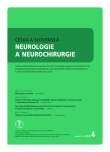Behavioral manifestation profi le in idiopathic REM sleep behavior disorder
Authors:
J. Nepožitek 1; C. Ünalp 1,2; S. Dostálová 1; I. Příhodová 1; V. Ibarburu Lorenzo Y Losada 1; P. Dušek 1; K. Šonka 1
Authors‘ workplace:
Neurologická klinika a Centrum klinických, neurověd, 1. LF UK a VFN v Praze
1; Faculty of Medicine, Ankara University, Ankara, Turkey
2
Published in:
Cesk Slov Neurol N 2019; 82(4): 437-441
Category:
Original Paper
doi:
https://doi.org/10.14735/amcsnn2019437
Overview
Aim: Abnormally prominent motor activity in rapid eye movement (REM) sleep is a major polysomnographic (PSG) feature of idiopathic REM sleep behavior disorder. The diagnosis is based on the complex nature of the movements, but more discreet motor manifestations can be seen in the video recording during PSG. The aim of this work was to perform a systematic video analysis of REM sleep movements.
Patients and methods: The motor manifestations identified in the video recording of PSG in 32 patients aged 67.4 ± 7.3 years were classified into four categories according to clinical severity (elementary, excessive, scenic and violent). In addition, topographic distribution, brief and slow characterization of movement, association with vocalization, subsequent wakefulness and emotional subtext were determined for each motor event.
Results: An average of 114.6 ± 85.1 motor phenomena was identified. Of these, 67.8% were classified as elementary, 9.1% as excessive, 22.3% as scenic, and 0.7% as violent. However, 31.3% of patients experienced violent manifestations. Brief movements were more frequent than slow ones (P = 0.001). Vocalization occurred in 34.4% of patients. Movement caused wakefulness in 9.4% of patients and was at least once associated with distinct emotion in 21.9%.
Conclusion: This study shows a large number of motor phenomena in REM sleep with extensive variability. Elementary events represent the vast majority. Although violent manifestations are captured in relative minority, they were detected in 31% of patients.
The authors declare they have no potential conflicts of interest concerning drugs, products, or services used in the study.
The Editorial Board declares that the manuscript met the ICMJE “uniform requirements” for biomedical papers.
特发性REM睡眠行为障碍的行为表现特征
目的:快速眼动(REM)睡眠中异常突出的运动活动是特发性REM睡眠行为障碍的主要多导睡眠图(PSG)特征。诊断是基于动作的复杂性,但是在PSG期间的视频记录中可以看到更多谨慎的运动表现。这项工作的目的是对REM睡眠运动进行系统的视频分析。
患者和方法:32例(67.4±7.3岁)患者PSG录像中发现的运动表现按临床严重程度分为4类(初级、过度、不良、暴力)。此外,每个运动事件的地形分布、运动的简短和缓慢特征、与发声的关联、随后的清醒状态和情绪潜台词也被确定。
结果:平均为114.6±85.1。其中,67.8%为初级,9.1%为过度,22.3%为不良,0.7%为暴力。然而,31.3%的患者有暴力表现。短暂运动比缓慢运动更频繁(P = 0.001)。34.4%的患者有发声障碍。9.4%的患者因运动而清醒,21.9%的患者至少有一次明显的情绪变化
结论:这项研究表明REM睡眠中有大量的运动现象,且变化很大。基本事件占绝大多数。尽管在少数人中捕获了暴力表现,但在31%的患者中发现了暴力表现。
关键字:快速眼动睡眠行为障碍–运动活动–快速眼动睡眠
Keywords:
REM sleep behavior disorder – motor activity – REM sleep
Sources
1. Schenck CH, Bundlie SR, Ettinger MG et al. Chronic behavioral disorders of human REM sleep: a new category of parasomnia. Sleep 1986; 9(2): 293– 308. doi: 10.1093/ sleep/ 9.2.293.
2. American Academy of Sleep Medicine, International classification of sleep disorders. 3rd ed. Darien, IL: American Academy of Sleep Medicine 2014.
3. Schenck CH. Rapid eye movement sleep behavior disorder: current knowledge and future directions. Sleep Med 2013; 14(8): 699– 702. doi: 10.1016/ j.slee2013.04.011.
4. McCarter SJ, St Louis EK, Boeve BF. REM sleep behavior disorder and REM sleep without atonia as an early manifestation of degenerative neurological disease. Curr Neurol Neurosci Rep 2012; 12(2): 182– 192. doi: 10.1007/ s11910-012-0253-z.
5. Arnulf I. REM sleep behavior disorder: motor manifestations and pathophysiology. Mov Disord 2012; 27(6): 677– 689. doi: 10.1002/ mds.24957.
6. McCarter SJ, St Louis EK, Boswell CL et al. Factors associated with injury in REM sleep behavior disorder. Sleep Med 2014; 15(11): 1332– 1338. doi: 10.1016/ j.slee2014.06.002.
7. Frauscher B, Gschliesser V, Brandauer E et al. The relation between abnormal behaviors and REM sleep microstructure in patients with REM sleep behavior disorder. Sleep Med 2009; 10(2): 174– 181. doi: 10.1016/ j.slee2008.01.003.
8. Manni R, Terzaghi M, Glorioso M. Motor-behavioral episodes in REM sleep behavior disorder and phasic events during REM sleep. Sleep 2009; 32(2): 241– 245. doi: 10.1093/ sleep/ 32.2.241.
9. Oudiette D, Leu-Semenescu S, Roze E et al. A motor signature of REM sleep behavior disorder. Mov Disord 2012; 27(3): 428– 431. doi: 10.1002/ mds.24044.
10. Frauscher B, Gschliesser V, Brandauer E et al. Video analysis of motor events in REM sleep behavior disorder. Mov Disord 2007; 22(10): 1464– 1470. doi: 10.1002/ mds.21561.
11. Berry RB, Brooks R, Gamaldo CE et al. for the American Academy of Sleep Medicine, The AASM Manual for the Scoring of Sleep and Associated Events: Rules, Terminology and Technical Specifications, Version 2.2. Darien, IL: American Academy of Sleep Medicine
2015.
12. Olson EJ, Boeve BF, Silber MH. Rapid eye movement sleep behaviour disorder: demographic, clinical and laboratory findings in 93 cases. Brain 2000; 123 (Pt 2): 331– 339. doi: 10.1093/ brain/ 123.2.331.
13. Lapierre O, Montplaisir J. Polysomnographic features of REM sleep behavior disorder: development of a scoring method. Neurology 1992; 42(7): 1371– 1374. doi: 10.1212/ wnl.42.7.1371.
14. Ferri R, Aricò D, Manconi M. 0681 Defining “subclinical” REM sleep behavior disorder. Sleep 2018; 41 (Suppl 1):
A252– A253. doi: 10.1093/ sleep/ zsy061.680.
15. Frauscher B, Gabelia D, Mitterling T et al. Motor events during healthy sleep: a quantitative polysomnographic study. Sleep 2014; 37(4): 763– 773. doi: 10.5665/ sleep.3586.
16. Peřinová P, Plchová L, Bušková J et al. Follow-up pacientů s idiopatickou poruchou chování v REM spánku – fenokonverze do parkinsonského syndromu a demence. Cesk Slov Neurol N 2018; 81/ 114(2): 205– 207. doi: 10.14735/ amcsnn2018205.
Labels
Paediatric neurology Neurosurgery NeurologyArticle was published in
Czech and Slovak Neurology and Neurosurgery

2019 Issue 4
Most read in this issue
- Multiple system atrophy
- Superior semicircular canal dehiscence
- Spina bifida in the Czech Republic – incidence and prenatal diagnostics
- Hearing loss after spinal anesthesia
